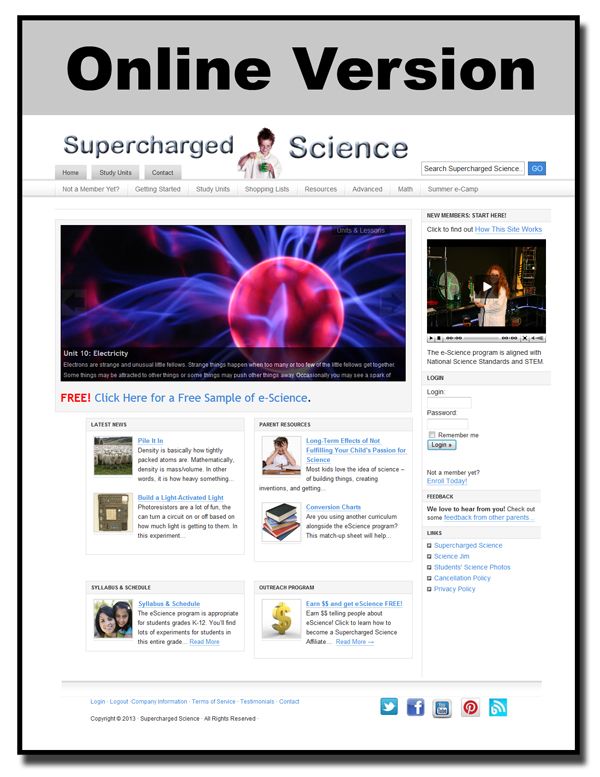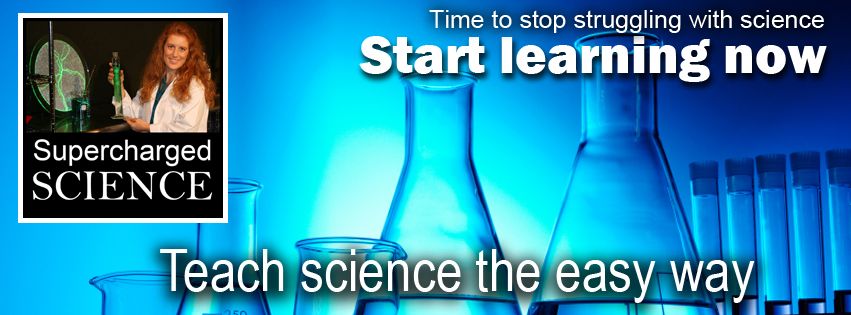Over this past month, we have had the privilege to review the e-science online learning program through Supercharged Science as a part of The Old Schoolhouse Review Crew.
 Supercharged Science is an online Science curriculum taught by a real scientist named Aurora Lipper. Her credentials include working for NASA as a rocket scientist, as well as teaching science on all levels, including at the university level. Her love for science is obvious in the passion she displays on her website, in her videos, and in her correspondence.
Supercharged Science is an online Science curriculum taught by a real scientist named Aurora Lipper. Her credentials include working for NASA as a rocket scientist, as well as teaching science on all levels, including at the university level. Her love for science is obvious in the passion she displays on her website, in her videos, and in her correspondence.This curriculum can be used as a stand alone science program in your homeschool, or it can be used as the "hands on" learning piece for an existing curriculum. While it is available for K-12th grade, we mainly used the curriculum to supplement my high schooler's current Chemistry program. Aurora has conveniently linked her lessons to most of the well known, popular curriculums to make it easy to match up what units of study and experiments would go with the current chapter we are studying. (If your curriculum is not listed, she offers to make a conversion chart for you!)
Watch the video for an overview of how the Supercharged Science program can work for homeschoolers!
This website was very overwhelming to me at first, just because of the sheer amount of information that was available. While I was granted access to the entire website for purposes of writing this review, it is my understanding that when a family purchases a subscription, they will be granted partial access, and more units will become available as the student works through them. Although at any time, if someone wishes to jump ahead to a different area of study, all they need to do is ask and non-accessible units will be made available.
Right away, the first thing I did was watch the Introduction video, which teaches how to use the program, and gives you a 'roadmap' of the most effective ways to work through the curriculum. There is literally dozens of pages of resources to 'teach the teacher'. One night I spent quite a while just reading through most of these, gleaning tips to inspire my children in their learning, teaching them HOW to think through a problem, and WHY it's important. All I can say is that it is very obvious that Aurora really cares about children learning science and enjoying it. There is an entire page (that could take you an hour or more to get through) that is devoted to how to use the program, and how to get the most out of it.
Once I got through that, I felt a lot more prepared to actually tackle some assignments! I started off with some of the easy ones on the Getting Started page, just to try things out. The Getting Started page includes 8 short experiments that really get the kids interested in the program, and are easy to do in a short space of time.
Our first experiment: The plasma grape ( this video is taken from Aurora Lipper's video feed on Youtube - while we did attempt to video/take pictures, our fascination with watching the results kept causing us to miss the actual 'moment' with the camera!)
Right across the top of the homepage, there are menu options to navigate the site. One feature I really like is the "shopping lists" that tell you what supplies you'll need for each unit and it's correlating experiments. Most of the experiments can be done with typical household items - there was not a lot of 'specialty' items to purchase. Although when specialty items are required, the program tries to make it easy by supplying part numbers, etc. so you can easily purchase.
The method Aurora encourages is for the student to first watch the video and whet their appetite for the concept being taught, then allow them to try the experiment for themselves. With a high schooler, there really is minimal parental involvement required, because most of the material is very self-explanatory. Although everything we tried ended up turning into a family affair because it was so interesting.
The program can be used for multiple grade levels, because the same set of experiments and concepts are taught, whether it is to an elementary student or a high school student. The difference is that there is much more reading, listening, and study work involved for the high school level. Most of the science at the high school level also uses more intricate math concepts. While an elementary student may watch the video and the experiment and have an idea what is going on, the high school student can delve much deeper by being able to process and explain scientifically why it is happening that way. I found the program to be easily adaptable up or down - more complex for the high schooler, but also easy to include the younger students.
A typical high school unit of study includes:
 ~ An introductory video to pique the student's interest in that particular unit and give an overview of what will be learned.
~ An introductory video to pique the student's interest in that particular unit and give an overview of what will be learned. ~ A written lesson plan for the teacher to use in overseeing the student, or for the student to follow. These include vocabulary definitions, and 50+ pages of lesson materials. It allows the teacher to be 'hands-on' with teaching the material.
~ An MP3 audio download of the lesson that is about 45 minutes long.
~ Videos and written material instruction. This is quite lengthy. It can be printed out and read, or read online.
~ Experiments - these are videos in the unit itself, as well as written instructions. The student is supposed to watch the video and then duplicate the experiment in a tactile way.
~There are also practical problems and quizzes that the student can use to round out their studies, as well as reading suggestions for extra study.
There literally is so much material available in each unit. Every experiment has a corresponding video to watch, as well as plenty of explanation of what is happening. Each experiment and posting has an interactive area to type in questions, which are promptly answered by Aurora. If a student doesn't understand a concept, they are never left hanging.
Aurora also has a dedicated weekly call in time to answer science questions regarding any of the material being studied on the website.
The videos seem to be just enough to attract the student's attention, get them interested in the subject, and motivate them to study it more. Most of the videos do not 'give away' all the details. They leave plenty of room for student discovery!
Some pictures of a few of our experiments:
Building a Barrel Roof out of a piece of paper.
One sheet of paper was able to hold up a stack of papers and folders!
Setting a dollar bill on fire....but it won't burn!
A few things I really liked: I love how adaptable the program is. Anyone can use it, at their own pace and in the way that works best for their family. Also, the program teaches and sticks to science. It does not delve into opinions. There is no mention of creation/evolution, earth age, or other philosophies and theories that would make this program difficult for a Christian to use.
Improvements: Some of the videos we watched could have a better sound or visual quality. There were a few 'housekeeping' items that I was going to mention regarding the website, but the website went through a makeover of sorts during our review period, and most of these were cleaned up and made more visually appealing! It seems like there is always something new or some improvement or upgrade being done on the website, which keeps it fresh, new, and exciting. Also, Aurora is constantly looking for feedback, and implementing ideas that are given.
What we are looking forward to: So far, we have used the program mostly as a supplementation to our regularly scheduled curriculum and daily science lessons. Soon we will be finished with our regular curriculum for the year, and we are looking into really working through some of the e-science units as a sole source of science lessons! There are a few 'heavily involved' projects that we would like to build that need more time than we can give it presently, such as a solar oven and an underwater robotic device. We are also looking forward to utilizing the online summer science camp that the website offers. I watched a few videos of previous summer science camps, and they are unbelievably cool. I know the girls will really enjoy working through this during the summer when they have less other work and more time to devote to it.
What it costs: A membership costs $37 a month for the K-8 level, and $57 a month for the grades 9-12 level.
System requirements: You will definitely need a strong internet connection and the latest version of your browser. Also, Adobe Reader and Flash Player. All system requirements can be seen here.
This page has a video introduction to the program and describes membership benefits in great detail.
Our opinion? Supercharged Science really makes learning science interesting and fun!
Want to see what other Crew members thought? Want to see some other pictures of cool experiments that can be found on Supercharged Science? Click the banner below!








Love your pictures. It has been fun to see what experiments others did. You peaked my interest on these two...off to find them :)
ReplyDelete